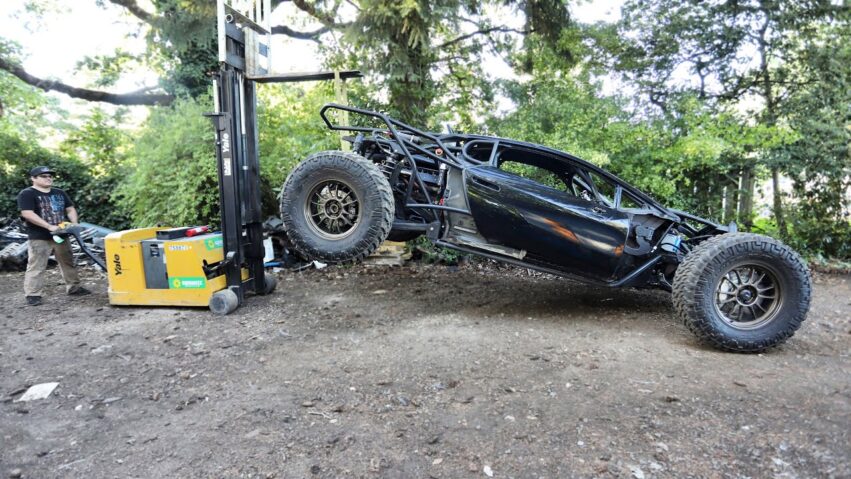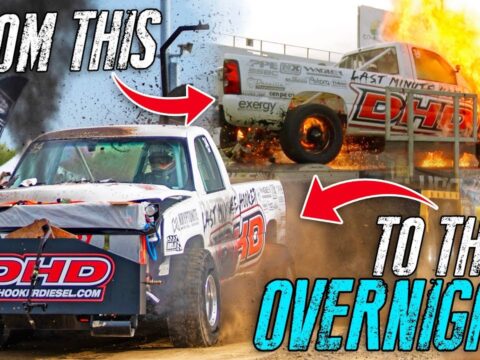In todays episode were repairing and improving both of the trailing arms on the #Jumpacan. And then were getting a forklift to raise it up in the air and drop it to see how the suspension does.
❱ Shop – http://bisforbuild.com/
❱ Patreon – http://www.patreon.com/user?u=3364742
❱ Facebook – http://facebook.com/bisforbuild
❱ Instagram – http://instagram.com/bisforbuild
❱ Twitch – https://www.twitch.tv/bisforbuild
Music:
Fareoh – Cloud Ten






yup. I think you found the root cause. Definitely needed some more ride height as well though. Just make sure you increase ride height enough on top of the new BLOCK height of your spring. So if your heavier spring has a 0.25" higher block height than the old one, I hope you get at least another 0.5" of compression travel out of your new spring + collar adjustments. You'll still only have about 0.25" of wiggle room though and that will put a lot of importance into your hydraulic bump stop settings. Some springs like SWIFT have a shorter block height than others but not always. Check with multiple spring manufactures on the same rate and length to see the difference. I had to go thru a similar experiment with rear shock travel on my Honda S2000 for racing but didn't drop the car with a forklift. I had an odd sudden oversteer under compression while in turn where the rear end would just loose grip in a hard transition. I took some measurements. Increased spring rates but also paid close attention to their block height and went with Hyperco springs. I installed the springs at a little higher ride height than before and did some real world testing and hit bump going over a bridge at different speeds to see how hard I could hit it until I'd get too deep into the bump stop. I eventually had to just hit it at 80mph without the bump stops on the shocks to see if I'd really ever fully compress the shock. I found out that if I even really hit something hard enough to block the springs, they'd block first, before my shock ran out of travel leaving about 0.25" left of shock compression travel. I cut down my bump stops to give me most of the travel though. If you're serious about racing an S2000, don't get shocks that have the same body dimension as stock like KW clubsports do. You wont like your end result ride height with 750lb springs.
I’m a mechanical engineer. I’m fairly confident if you put a laser on the 4 frame pivot points for the rear suspension on either side you will find the forward lower pivot is not on the same plane as the other 3. If all 4 pivots are not on the same plane in space your suspension will bind. I think with all the reinforcing plates the alignment of that particular pivot point got a little off. That bolt was just the weakest link.
The breakage was not your fault just an initial “bad engineering” ( not saying it in a bad way it happens on prototypes like your) bolts like that are not made to take leverage as they did. Those bolts can hold like 20 tons each sandwiched between two plates but can brake “easily” if you use them to stand leverage. Your problem should be fixed. Can’t wait to see that beast racing.
It's still way too low!.b=build more!
Love to see these lessons learned as you go. Stay safe and have fun!
Wasn't there some kind of hot rod he was building from scratch months ago? Whatever happened to that?
OMG! chris you need to get the boys waterjet for Xmas would save you hours cutting stuff #flowjetforB Come on flow jet sponsor chris and the boys !
2:30 all of that is what she said
you need a tywrap around the damper shaft so you can see how much travel you're using, but either way it looks like the bump stop needs adjusting so that the damper can't bottom out.
Coil bind.
So I slowed down the speed during your slowmo.. interesting to see everything going that slow.
Do a super slow motion of Oscar welding, I want to see him lay a bead. Please and thank you.
Why did the coating fail when you guys were drilling holes to add the pieces you forgot too. At 7:28 or so
Your top springs aren't moving at all so your not even using the second rate of the dual rate springs. It's like you have a locking ring instead of a crossover sleeve.
New t-shirt idea: "Oscar to the Rescue". Hats and Bumper Sticker also available……..The "Man" is a Fabrication Wizard!!!!!!!!
Your problem is trying to jump something with 3 inches of ground clearance. It pretty clearly smacked the ground on the last video when it was jumped.
In today's episode, we turn the jumpacan into the bounceacan.
I like that you admitted to learning something new, that double sheer point thing is very cool, I learned something new too! Thanks bro!
Shouldn't the bump stops prevent the shock from bottoming out though ?
"We got bigger nuts too."
Yea, I knew that when I started watching the channel. Some of thr builds you guys do are crazy and hard af
B is for cardboard cut out models
You have not introduced a double shear loading case, you have simply removed the moment force on the bolt in combination with the shear force that lead to the failure.
It fell
Still to less ground clearance for racing in the dunes, I've got a bad feeling.😐
pretty much the entire first 2 minutes is just a bunch of thats what she said jokes
Oscar is an artist. So much fun watching his fab skills.
Shouldn’t the guy at SEM DIRT have already known to do this when designing the frame? Or is this issue not a common thing? (Not hating just curious, wasn’t really into off-road builds till this one) 👍🏾